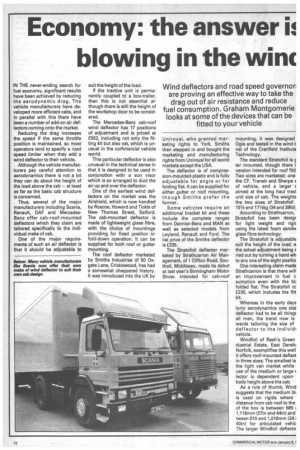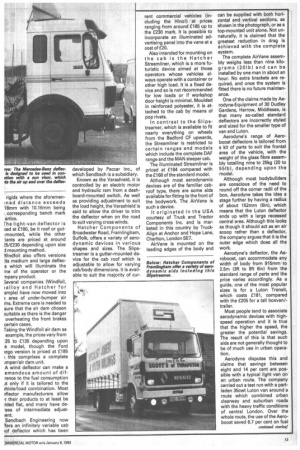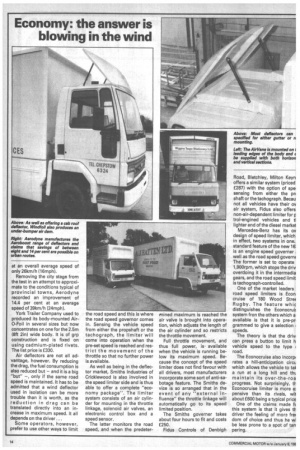Economy: the answer blowing in the winc
Page 14

Page 15

Page 16

If you've noticed an error in this article please click here to report it so we can fix it.
Wind deflectors and road speed governor are proving an effective way to take the drag out of air resistance and reduce fuel consumption. Graham Montgomerie looks at some of the devices that can be fitted to your vehicle
IN THE never-ending search for fuel economy, significant results have been achieved by reducing the aerodynamic drag. The vehicle manufacturers have developed more efficient cabs, and in parallel with this there have been a number of add-on air deflectors coming onto the market.
Reducing the drag increases the speed if the same throttle position is maintained, so most operators tend to specify a road speed limiter when they add a wind deflector to their vehicle.
Although the vehicle manufacturers pay careful attention to aerodynamics there is not a lot they can do about the height of the load above the cab — at least as far as the basic cab structure is concerned.
Thus, several of the major manufacturers including Scania, Renault, DAF and MercedesBenz offer cab-roof-mounted deflectors which they claim are tailored specifically to the individual make of cab.
One of the major requirements of such an air deflector is that it should be adjustable to suit the height of the load.
If the tractive unit is permanently coupled to a box-trailer, then this is not essential although there is still the height of the workshop door to be considered.
The Mercedes-Benz cab-roof wind deflector has 17 positions of adjustment and is priced at £552, including not only the fitting kit but also vat, which is unusual in the cothmercial vehicle world.
This particular deflector is also unusual in the technical sense in that it is designed to be used in conjunction with a sun visor which is so arranged to duct the air up and over the deflector.
One of the earliest wind deflectors on the market was the Airshield, which is now handled by Roscoe, Howard and Tickle of New Thomas Street, Salford. The cab-mounted deflector is made of lightweight glass fibre, with the choice of mountings providing for fixed position or fold-down operation. It can be supplied for both roof or gutter mounting.
The roof deflector marketed by Smiths Industries of 50 Oxgate Lane, Cricklewood, has had a somewhat chequered history. It was introduced into the UK by Uniroyal, who granted marketing rights to York. Smiths then stepped in and bought the marketing and manufacturing rights from Uniroyal for all world markets except the USA.
The deflector is of compression-moulded-plastic and is fully adjustable for angle or for folding flat. It can be supplied for either gutter or roof mounting, though Smiths prefer the former.
Some vehicles require an additional bracket kit and these include the complete ranges from Daimler-Benz and MAN as well as selected models from Leyland, Renault and Ford. The list price of the Smiths deflector is £235.
The Stratofoil deflector marketed by Strathcarron Air Management, of 1 Clifton Road, Southall, Middlesex, made its debut at last year's Birmingham Motor Show. Intended for cab-roof mounting, it was designed Ogle and tested in the wind t nel of the Cranfield Institute Technology.
The standard Stratofoil is c ter mounted, though there i version intended for roof fitti Two sizes are marketed: one the CF. Transit and Sherpa s of vehicle, and a larger aimed at the long haul tract unit size of cab. The weights the two sizes of Stratofoil 151/2 and 171/2k9 (34 and 391b).
According to Strathcarron, Stratofoil has been desigr for light weight and rigic using the latest foam sandw glass fibre technology.
The Stratofoil is adjustable suit the height of the load, ,t1 the actual adjustment being c tied out by turning a hand wh to any one of the eight positio One interesting claim made Strathcarron is that there will an improvement in fuel c sumption even with the NI folded flat. The Stratofoil cc £235, which includes the fitt kit.
Whereas in the early days lorry aerodynamics one size deflector had to be all things all men, the trend now is wards tailoring the size of deflector to the individi vehicle.
Windfall of Rash's Green dustrial Estate, East Derehi Norfolk, exemplifies this well it offers roof-mounted deflect in three sizes. The smallest is the light van market while use of the medium or large it lector is dependent upon body height above the cab.
As a rule of thumb. Wind suggests that the medium bli is used on rigids where distance from cab roof to the of the box is between 685 1,118mm (27in and 441n) and tween 610 and 1,016mm (244 40in) for articulated vehic The larger Windfoil deflect° rigids where the aforemen ■ n ed distance exceeds 18mm with 10.16mm being corresponding bench mark artics.
rhe light-van deflector is ced at £190, be it roof or gut-mounted, while the other iants are priced at around ?5/£230 depending upon size mounting method.
Afindfoil also offers versions its medium and large deflecs which will illuminate the me of the operator or the -npany product.
ieveral companies (Windfoil, ialloy and Hatcher for ample) have now moved into ? area of under-bumper air ms. Extreme care is needed to sure that the air dam chosen witable as there is the danger overheating the front brakes certain cases.
Taking the Windfoil air dam as example, the prices vary from 25 to £135 depending upon e model, though the Ford 3rgo version is priced at £185
this comprises a complete imper/air dam unit.
A wind deflector can make a emendous amount of difrence to the fuel consumption it only if it is tailored to the ?hicle/load combination. Most 3flector manufacturers allow r their products to at least be dded flat, and many have de-ees of intermediate adjustent.
Sandbach Engineering now lers an infinitely variable cab of deflector which has been developed by Paccar Inc., of which Sandbach is a subsidiary.
Known as the Varashield, it is controlled by an electric motor and hydraulic ram from a dashboard-mounted switch. As well as providing adjustment to suit the load height, the Varashield is said to allow the driver to trim the deflector when on the road to suit varying cross winds.
Hatcher Components of Broadwater Road, Framling ham, Suffolk, offers a variety of aerodynamic devices in various shapes and sizes. The Slipstreamer is a gutter-mounted device for the cab roof which is adjustable to allow for varying cab/body dimensions. It is available to suit the majority of cur rent commercial vehicles (including the Hino!) at prices ranging from around £185 up to the £230 mark. It is possible to incorporate an illuminated advertising panel into the vane at a cost of £20.
Also intended for mounting on the cab is the Hatcher Streamliner, which is a more futuristic device aimed at those operators whose vehicles always operate with a container or other high load. It is a fixed device and so is not recommended for low loads or if workshop door height is minimal. Moulded in reinforced polyester, it is attached to the cab by means of pop rivets.
In contrast to the Slipstreamer, which is available to fit nearly everything on wheels from the Bedford CF upwards, the Streamliner is restricted to certain ranges and models which include the complete DAF range and the MAN sleeper cab.
The illuminated Streamliner is priced at £184 compared with the £168 of the standard model.
Although most aerodynamic devices are of the familiar cabroof type, there are some aids available for fitting to the front of the bodywork. The AirVane is such a device.
It originated in the USA courtesy of Truck and Tractor Components Inc. and is marketed in this country by TruckAlign at Anchor and Hope Lane, Charlton, London SE7.
AirVane is mounted on the leading edges of the body and can be supplied with both horizontal and vertical sections, as shown in the photograph, or as a top-mounted unit alone. Not unnaturally, it is claimed that the greatest reduction in drag is achieved with the complete system.
The complete AirVane assembly weighs less than nine kilograms (2 01b) and can be installed by one man in about an hour. No extra brackets are required, and once the system is fitted there is no future maintenance.
One of the claims made by Aerodyne-Equipment of 30 Dudley Gardens, Harrow, Middlesex, is that many so-called standard deflectors are incorrectly styled and sized for the smaller type of van and Luton.
Aerodyne's range of Aeroboost deflectors is tailored from a kit of parts to suit the frontal area of the vehicle, with the weight of the glass fibre assembly totalling nine to 25kg (20 to 551b), depending upon the model.
Although most bodybuilders are conscious of the need to round off the corner radii of the box, Aerodyne takes the idea a stage further by having a radius of about 152mm (6in), which means that the Luton deflector ends up with a large recessed central area. Although this looks as though it should act as an air scoop rather than a deflector, the company argues that it is the outer edge which does all the work.
Aerodyne's deflector, the Aeroboost, can accommodate any width of body from 915mm to 2.5m (3ft to 8ft 6in) from the standard range of parts and the price varies accordingly. As a guide, one of the most popular sizes is for a Luton Transit, which costs £181, compared with the £205 for a tall boxyan/trailer.
Most people tend to associate aerodynamic devices with highspeed operation and it is true that the higher the speed, the greater the potential savings. The result of this is that such aids are not generally thought to be of much use in urban operation.
Aerodyne disputes this and claims that savings between eight and 14 per cent are possible with a typical light van on an urban route. The company carried out a test run with a partladen 35cwt Luton van around a route which combined urban clearway and suburban roads with the heavy traffic conditions of central London. Over the whole route, the use of the Aeroboost saved 8.7 per cent on fuel at an overall average speed of only 26km/h (16mph).
Removing the city stage from the test in an attempt to approximate to the conditions typical of provincial towns, Aerodyne recorded an improvement of 14,4 per cent at an average speed of 39km/h (24mph).
York Trailer Company used to produced its body-mounted Air0-Foil in several sizes but now concentrates on one for the 2.5m (8ft 2in) wide body. It is of grp construction and is fixed on using cadmium-plated rivets. The list price is £330.
Air deflectors are not all advantage, however. By reducing the drag, the fuel consumption is also reduced but — and it is a big "but" —, only if the same road speed is maintained. It has to be admitted that a wind deflector used in isolation can be more trouble than it is worth, as the reduction in drag can be translated directly into an increase in maximum speed. It all depends on the driver.., Some operators, however, prefer to use other ways to limit the road speed and this is where the road speed governor comes in. Sensing the vehicle speed from either the propshaft or the tachograph, the limiter will come into operation when the pre-set speed is reached and restrict the movement of the throttle so that no further power is available.
As well as being in the deflector market, Smiths Industries of Cricklewood is also involved in the speed limiter side and is thus able to offer a complete "economy package". The limiter system consists of an air cylinder for mounting in the throttle linkage, solenoid air valves, an electronic control box and a speed sensor.
The latter monitors the road speed, and when the predeter rnined maximum is reached the air valve is brought into operation, which adjusts the length of the air cylinder and so restricts the throttle movement.
Full throttle movement, and thus full power, is available when the vehicle is running below its maximum speed. Because the concept of the speed limiter does not find favour with all drivers, most manufacturers incorporate some sort of anti-sabotage feature. The Smiths device is so arranged that in the event of any "external influence" the throttle linkage will automatically go to its speed limited position.
The Smiths governer takes about four hours to fit and costs £250.
Fidus Controls of Denbigh Road, Bletchley, Milton Keyn offers a similar system (priced £287) with the option of spei sensing from either the pri shaft or the tachograph. Becau not all vehicles have their ov air system, Fidus also offers non-air-dependent limiter for p trol-engined vehicles and ti lighter end of the diesel market Mercedes-Benz has its ov design of speed limiter, which in effect, two systems in one. standard feature of the new 16: is an engine speed governer well as the road speed govern( The former is set to operate 1,900rpm, which stops the driv overdoing it in the intermedia gears, and the road speed limit is tachograph-controlled.
One of the market leaders road speed limiters is Econ, cruise of 180 Wood Stret Rugby. The feature whic distinguishes the Econocruii system fron the others which al available is that it is pre-pri grammed to give a selection speeds.
The theory is that the drivi can press a button to limit h vehicle speed to the type i road.
The Econocruise also incorpi rates a hill-anticipation circu which allows the vehicle to tal+ a run at a long hill and thi. maintain its over-the-roa progress. Not surprisingly, th Econocruise limiter is more e: pensive than its rivals, wit about £600 being a typical price One of the claims made ft this system is that it gives th driver the feeling of more frei dom of choice and thus he wi be less prone to a spot of tarr pering.








































































